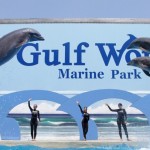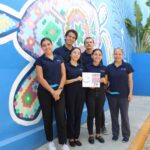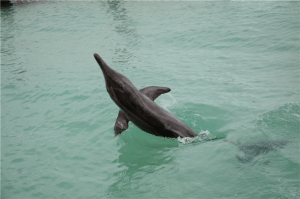
Steno the dolphin
Dolphin Discovery rescued a dolphin in a critical state off the coast of Cancun, after one month of medical care she has been returned to the sea.
August 12, 2013 at 2 a.m., the Dolphin Discovery rescue team received a call from the authorities of the Federal Environmental Protection Agency (PROFEPA) about a dolphin on the rocks of a beach in Cancun in a very weak state, yet still alive. The fire department’s rescue team got the dolphin off the rocks and onto a stretcher until professional assistance could arrive.
The Dolphin Discovery veterinary team lead by Dr. Roberto Sanchez Okrucky and the trainers under the direction of Edgar Urbina arrived in the middle of the night to help the animal that was in a critical state. The dolphin was a female around 15 years old of age and from the species steno bredanensis, not very commonly seen through the Cancun waters. In a joint decision with the authorities, it was decided to transfer the female to the Turtle Farm on Isla Mujeres using the Dolphin Discovery boats.
The possibility of placing the rescued dolphin with the other dolphins located in Dolphin Discovery Isla Mujeres was almost zero, for the rescue protocols are very strict and there was a big chance of Steno having a viral and contagious illness. The risk of zoonosis and infection of the 22 dolphins in Isla Mujeres was too high.
The Turtle Farm has the function of a quarantine location, with a large area and quick access for the veterinarians and trainers, respecting the natural environment of the animals. The first moments of the dolphin’s arrival were not good, she sank, and was barely breathing, she rolled on her side and required human assistance to swim. Thanks to the medical team and intense treatments in her first hours of rescue, she was able to stabilize and swim on her own, though very slowly.
The following 10 days were full of constant medical testing; ultrasounds, daily blood samples, stomach content analysis, respiratory cultures, parasitology tests, all possible human and economic effort to determine the cause of the dolphin’s stranding. Her appetite for fish was good and the trainers and veterinarians took care of her 24 hours a day in a protective manner, without entering the water so she would not get accustomed to a human presence.
It was determined that she was suffering from acute hepatic cirrhosis, the liver was badly damaged. Her diet was modified to soft solids, mostly squid which has a high water content and capelin which contains water and fiber. Eliminating fats from her diet was the first step in her treatment and recuperation from her disease.
After 20 days her behaviors returned to almost normal, her swimming speed increased with more strength, her breathing became slower and stronger…we were beginning to see a light in the journey. Finally, after one month of treatment and constant communication with PROFEPA regarding the status of her health, a joint decision was made that she was ready to be liberated to continue her natural course.
From the first day, the intentions of Dolphin Discovery and PROFEPA were to rehabilitate and liberate this dolphin, it was not the first time both institutions have worked together and we will continue to do so for the well-being of the animals. On some occasions the rescued animals are not candidates to be returned to the wild because of their critical state or there is nowhere to free them, as in the case of the one day old manatee rescued in 2009 who was rehabilitated and relocated to a natural environment in Dolphin Discovery Puerto Aventuras where it is thriving along with 6 other manatees without a problem.
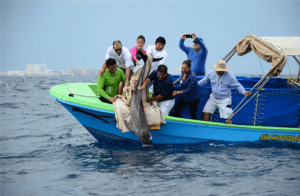
Steno liberation
The case of Steno the dolphin’s recovery is rare, the majority of beached dolphins are found dead or close to it, being dragged along the coast by the currents. That was not the case this time as our friend had the good fortune to be aided by a professional human team with 18 years of experience in veterinary medicine and training of marine mammals, she was given a second chance of life.
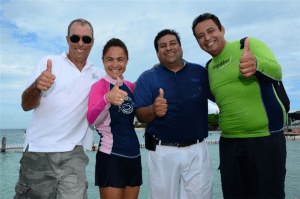
Dolphin Discovery team



